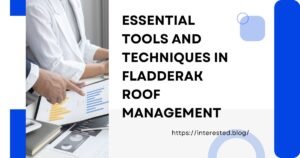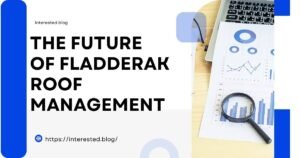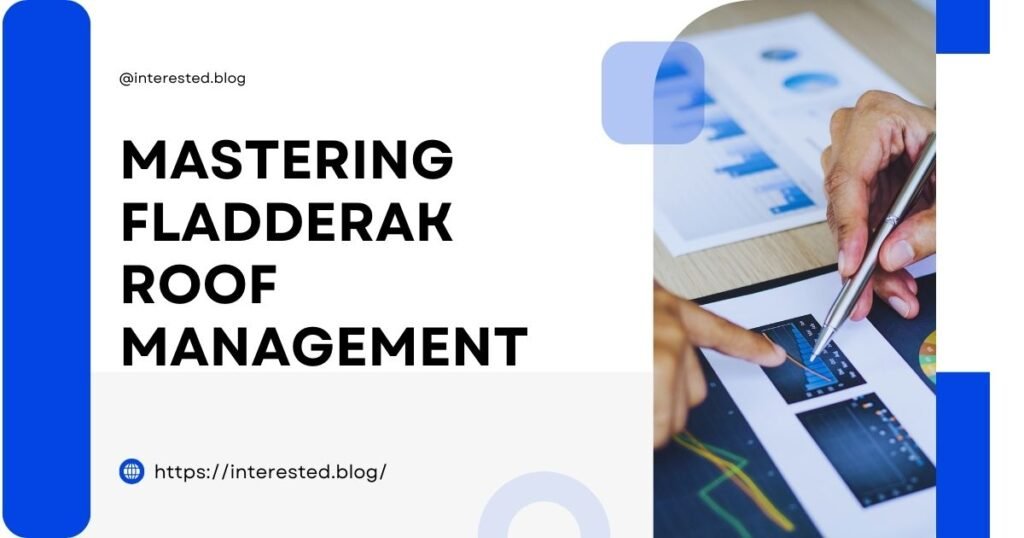Introduction
When was the last time you thought about your roof? For most people, the roof only becomes a priority when there’s a leak or a storm has caused visible damage. Yet, proactive care is what separates costly emergency repairs from sustainable property protection.
That’s where fladderak roof management comes into play. It’s not just about patching up holes or replacing shingles—it’s a holistic, forward-thinking approach to keeping roofs durable, efficient, and long-lasting.
Why does this matter? Because whether you’re a homeowner, a business operator, or a facility manager, your roof is a massive investment. Ignoring it can lead to sky-high costs, safety hazards, and energy inefficiency.
This guide will walk you through everything you need to know about fladderak roof management—from its origins and principles to real-world applications, cost breakdowns, and future innovations.
The Origins of Fladderak Roof Management
The term may sound modern, but the philosophy behind it has roots in traditional roofing practices that prioritized durability and protection. For centuries, property owners focused mainly on patching visible issues, but the underlying problems often went unnoticed until major repairs were needed.
- Traditional approaches focused on reactive maintenance—waiting until something broke before fixing it, often leading to higher costs and wasted resources.
- Modern fladderak management flips the script. It emphasizes preventive inspections, sustainable materials, and technology-driven monitoring that extend roof lifespan dramatically.
Think of it like car maintenance. Instead of driving until the engine dies, you schedule oil changes, check tire pressure, and replace filters. Similarly, fladderak roof management ensures longevity by catching issues before they spiral, saving both time and money while giving property owners confidence in their investment.
Why Fladderak Roof Management Is Gaining Attention
So, why is everyone suddenly talking about it? Several powerful factors are driving the shift and bringing this concept into the spotlight:
- Sustainability demands: As green building standards rise, eco-friendly roofs are no longer optional but a vital part of environmental responsibility.
- Cost awareness: A small leak ignored today can lead to thousands in water damage tomorrow, draining budgets unexpectedly.
- Asset protection: For businesses, a roof isn’t just a cover—it protects assets, employees, operations, and even reputation in competitive markets.
Studies show that roofs managed under preventive systems last up to 40% longer than those without a structured plan. That means fewer replacements, fewer disruptions, and more money saved. Over time, this shift transforms roofing from a liability into a long-term asset with measurable value.
Core Principles of Fladderak Roof Management
At its core, this method revolves around three critical pillars that define its long-term effectiveness and sustainable outcomes for every property type:
- Inspection and preventive care – Regular checkups detect early signs of wear before they become costly disasters requiring major interventions.
- Energy efficiency and responsibility – Roofs play a major role in reducing heating and cooling costs, lowering monthly bills significantly.
- Material optimization – Choosing the right materials ensures durability and lowers lifecycle costs, while also improving overall building performance.
It’s like treating your roof as a living system rather than a static structure. By respecting these principles, property owners extend roof life while also enhancing comfort, sustainability, and operational savings in meaningful, measurable ways.
Common Roofing Challenges Addressed by Fladderak Roof Management
Roofs endure daily battles with nature, and without structured care, these challenges eventually turn into costly repairs that drain budgets quickly. Some common issues include:
- Weather damage: Heatwaves, snow, storms, and high winds all strain roofing systems, wearing them down year after year.
- Moisture and leaks: Even a tiny crack can allow water intrusion, leading to mold, decay, and interior damage if left untreated.
- Structural stress: Over time, roofs bear the weight of equipment, debris, and shifting foundations, all of which create vulnerabilities.
With structured fladderak roof management, these issues are anticipated rather than reacted to. Preventive care turns unpredictable risks into manageable maintenance tasks, saving money and protecting both residential and commercial properties from serious harm.
Essential Tools and Techniques in Fladderak Roof Management

The modern toolkit goes far beyond ladders and hammers, reflecting the evolution of roofing into a technology-driven discipline focused on precision:
- Drones and thermal imaging allow safer, quicker inspections without putting workers at risk, while capturing detailed data for analysis.
- Advanced sealants and coatings repel water and UV rays, extending roof life while reducing environmental stress on building materials.
- Digital monitoring systems send alerts when irregularities are detected, ensuring that issues are addressed before they escalate into crises.
Technology ensures that roof care is not guesswork—it’s science-driven precision. Property owners gain real-time insights that help plan maintenance schedules intelligently, reducing unnecessary expenses and improving overall building resilience.
The Role of Professional Expertise in Fladderak Roof Management
DIY videos may make roof care look simple, but professionals bring a wealth of expertise and perspective that no online guide can replace.
- Trained eyes for spotting invisible risks that homeowners or business operators might overlook during casual checks.
- Compliance knowledge to meet safety regulations, building codes, and insurance requirements that vary between regions and industries.
- Specialized equipment that ensures thorough, lasting results far beyond what consumer tools can deliver effectively.
Hiring a skilled provider is often the difference between a patch job and a long-term solution. Experts not only repair and maintain but also advise on material choices, energy efficiency upgrades, and strategies that maximize a roof’s performance throughout its lifecycle.
Fladderak Roof Management vs. Conventional Roof Maintenance
How is it different from standard upkeep? The answer lies in philosophy, approach, and the long-term outcomes property owners experience when choosing either path.
- Philosophy: Conventional = fix when broken. Fladderak = prevent before breaking, which reduces overall risks dramatically over time.
- Costs: Upfront investment may be higher, but ROI is far greater because expensive emergencies are reduced significantly.
- Longevity: Traditional roofs average 15–20 years, while managed systems often exceed 25 with proper preventive planning.
It’s the classic case of short-term savings vs. long-term value. While traditional methods provide immediate fixes, fladderak roof management builds resilience, efficiency, and performance that add measurable worth to any property.
Sustainability and Eco-Friendly Roofing Through Fladderak Roof Management
Eco-conscious roofing isn’t a trend—it’s a necessity, especially as the effects of climate change become more severe with each passing year. The benefits include:
- Reduced carbon footprint through solar integration and green materials that align with modern environmental standards and certifications.
- Extended roof life with recyclable membranes and coatings, reducing landfill waste and unnecessary replacements.
- Energy efficiency that lowers monthly bills and decreases a building’s overall energy dependency dramatically.
A managed roof not only saves money but also supports global sustainability goals. By integrating eco-friendly practices, fladderak roof management ensures that environmental responsibility is balanced with financial and structural benefits for property owners.
Fladderak Roof Management for Residential Properties
For homeowners, it’s about peace of mind and protecting one of life’s largest investments—the family home. Strategies include:
- Scheduling inspections after every major season, especially after storms, snow, or extreme heat waves that can cause unseen damage.
- Clearing debris and maintaining gutters to prevent clogs that lead to water intrusion and structural problems.
- Upgrading insulation for better energy performance, comfort, and long-term savings on household utility bills.
The most common mistake? Waiting until there’s visible damage. Proactive care avoids costly repairs. By adopting fladderak roof management, homeowners ensure safety, efficiency, and long-term reliability without the stress of sudden emergencies.
Fladderak Roof Management for Commercial Buildings
Commercial properties face unique challenges that make a structured system essential for maintaining both safety and profitability:
- Large-scale roofs demand digital monitoring for efficiency, since manual inspections alone may miss critical warning signs.
- Compliance requirements make inspections legally necessary to meet building codes, insurance demands, and industry regulations.
- Business continuity means avoiding disruptions caused by leaks, structural failures, or downtime from unexpected roof problems.
For companies, adopting fladderak roof management is as much about protecting reputation as it is about saving costs. Well-maintained roofs reduce risks, ensure smooth operations, and safeguard valuable assets stored within facilities
Case Studies: Successful Fladderak Roof Management Applications
- Residential: A suburban homeowner extended roof life by 12 years through consistent inspections, eco-friendly upgrades, and seasonal cleaning. The investment was modest, but the returns were immense.
- Commercial: A warehouse cut energy bills by 25% after integrating reflective membranes, predictive monitoring, and sustainable materials that boosted insulation.
Lesson learned? Proactivity always pays. Case studies prove that fladderak roof management delivers real-world benefits, whether the goal is cost savings, sustainability, or reliability. Both small homes and large enterprises benefit when prevention becomes the strategy.
Cost Breakdown of Fladderak Roof Management
Let’s talk numbers in detail, since cost is always a top concern for property owners considering this system:
- Initial investment: Higher than traditional maintenance because it integrates inspections, monitoring, and advanced sealing solutions from the start.
- ROI: Savings from avoided repairs, extended lifespan, and reduced energy use typically offset the upfront expense within just a few years.
- Typical costs: Service plans vary but usually range between $0.15–$0.30 per square foot annually depending on property size and features.
Budgeting tip: Allocate at least 1–2% of property value annually for preventive roof care. Over time, this simple budgeting habit transforms roof care from unpredictable expense into a manageable, planned investment.
How to Build a Fladderak Roof Management Plan
Here’s a simple roadmap that property owners can use to start building their own structured system today:
- Schedule a professional inspection to create a baseline report that outlines current risks and future needs.
- Create a seasonal maintenance timeline with clear dates for checks, cleaning, and preventive treatments tailored to your climate.
- Set aside a roof management budget, ensuring funds are always available for inspections and minor repairs when needed.
- Incorporate digital monitoring if possible, giving you real-time updates on performance, leaks, or weather impacts.
- Review the plan annually for adjustments, making changes as your building or local environment evolves over time.
Think of it as a health plan for your roof. Just as people need regular checkups, roofs need structured care that prioritizes prevention and extends lifespan significantly.
Fladderak Roof Management and Smart Technology
We’re in the age of smart buildings—roofs included. Technology has advanced so rapidly that managing a roof now feels futuristic.
- IoT sensors track moisture, temperature, and pressure, sending alerts instantly when something deviates from safe conditions or expected patterns.
- Predictive analytics forecast potential failures, allowing owners to act before issues worsen and prevent expensive long-term consequences.
- Drones with AI map and analyze roof conditions in real time, reducing human error and increasing inspection efficiency.
This isn’t science fiction—it’s happening right now. By incorporating these technologies, fladderak roof management ensures every decision is data-driven, reliable, and optimized for future challenges.
The Future of Fladderak Roof Management

What’s next for this evolving practice? The future promises a fascinating blend of innovation, sustainability, and adaptability shaped by global challenges.
- Greater integration with climate resilience strategies, ensuring roofs can withstand storms, floods, heat waves, and shifting weather patterns.
- More use of self-healing materials that repair minor cracks or punctures automatically, extending roof lifespans without constant intervention.
- Wider adoption of AI-driven systems that analyze massive datasets, providing predictive care tailored to specific regions and building types.
As weather patterns become more extreme, roofs will need to evolve—and management systems will be at the forefront. Fladderak strategies provide resilience that future-proofs properties against unpredictable conditions and rising maintenance costs.
Fladderak Roof Management Mistakes to Avoid
Even the best system fails when common mistakes creep into practice. Here are pitfalls every property owner should work hard to avoid:
- Ignoring small issues until they escalate into major repairs that cost thousands and shorten the roof’s useful life.
- Relying only on annual inspections instead of ongoing checks or digital monitoring, which leaves gaps in long-term protection strategies.
- Cutting corners with cheap, low-quality materials that wear out quickly and undermine the durability achieved by structured management.
Remember: prevention is cheaper than repair. Fladderak roof management delivers full benefits only when implemented consistently, with commitment to quality and proactive care.
Comparing Fladderak Roof Management Providers
Not all providers are created equal. Choosing the right partner determines whether your investment delivers sustainable results or short-term fixes.
Before hiring, ask:
- What’s included in the service contract, and how detailed are the inspection reports provided?
- Do they use modern inspection tools like drones, thermal imaging, and predictive analytics for more accurate assessments?
- Can they provide case studies, references, or testimonials from previous clients to demonstrate proven experience and reliability?
Red flags include vague pricing, lack of certifications, or pressure-selling tactics. A strong provider should demonstrate transparency, expertise, and commitment to your property’s long-term health.
Fladderak Roof Management and Insurance Benefits
Did you know proactive roof care can lower insurance premiums significantly? Insurers reward responsibility because it reduces their overall claim risks.
- Insurers see managed roofs as lower-risk, meaning fewer claims and better reliability, which often results in discounted rates.
- Documentation from regular inspections simplifies claims by providing clear proof of preventive care and existing conditions.
- Preventive care often qualifies for discounts, since well-maintained roofs have fewer emergencies that lead to costly claims.
It’s a win-win for property owners. With fladderak roof management, you don’t just save on maintenance—you also build financial leverage with your insurance company.
Integrating Fladderak Roof Management with Overall Property Care
A roof doesn’t stand alone—it’s part of an interconnected property system that relies on synergy for maximum efficiency and performance.
- HVAC efficiency – Poor insulation or leaks overwork heating and cooling systems, increasing utility bills unnecessarily.
- Plumbing safety – Leaks can damage pipes and walls, leading to more costly structural or water-related issues long-term.
- Property value – A strong roof increases resale potential, creating confidence for buyers and investors alike.
Integration ensures the entire building works as a unit. Fladderak roof management becomes a foundation for overall building care, boosting efficiency, sustainability, and long-term value in measurable ways.
Final Thoughts
Fladderak roof management is more than maintenance—it’s a mindset shift. Instead of reacting to problems, you anticipate them. Instead of settling for short-term fixes, you invest in long-term solutions.
By adopting this approach, property owners not only protect their assets but also save money, reduce environmental impact, and ensure peace of mind.
So, the next time you glance at your roof, ask yourself: Am I simply waiting for the next problem, or am I managing my roof for the future?
Now’s the time to invest in fladderak roof management—and secure the durability, efficiency, and value of your property for years to come.
FAQs About Fladderak Roof Management
Q: How often should a roof be inspected under this system?
At least twice a year—once in spring and once before winter—plus after major storms.
Q: Is fladderak roof management suitable for older buildings?
Yes. In fact, older structures benefit even more from preventive strategies.
Q: What materials benefit most from this method?
Metal, membrane, and composite roofs respond best, but all materials gain longevity from proper care.
Q: Does it cost more than traditional roof maintenance?
Upfront, yes. But long-term ROI makes it more affordable over time.
Q: Can small residential homes adopt it effectively?
Absolutely—tailored plans make it scalable for any property size.
Read More Content: Number Avstarnews


